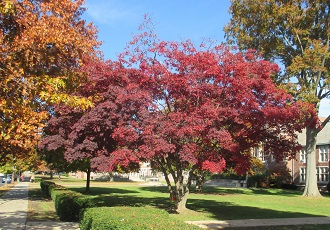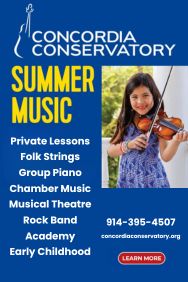Protecting Your Bronxville Property from Falling Trees and Keeping Trees Healthy

By Ellen Edwards, Member, Bronxville Green Committee
Nov. 28, 2018: As storms in recent months have reminded us, the mature tree canopy that so graces and defines Bronxville cannot be taken for granted. Strong winds and torrential downpours have undermined root systems and upended hundred-year-old trees, some with trunks five or six feet in diameter. Residents have expressed concern about how to protect their property from falling trees and keep their trees healthy and safe.
According to Deanna Curtis, curator of Woody Plants and landscape project manager at The New York Botanical Garden, recent storms are not historically stronger than storms of the past, but their ever-increasing frequency is not normal. That frequency combined with the heavily built environment—extensive pavement and construction that provide less surface area for rainwater to be absorbed into the ground—has significantly changed run-off patterns and increased flooding. Exposed ground becomes more saturated, making trees vulnerable. When they fall, they can take other trees down with them and damage root systems that are entwined with their own.
Trees are also prey to invasive plant species such as Asiatic bittersweet, porcelain-berry, winged euonymus, and black locust. According to Curtis, invasive species brought onto residential property by birds and other animals can out-compete established trees. As Bronxville trees reach what is typically “old age” for urban/suburban trees—the average lifespan of a street tree is only 25 years—they are more prone to disease; damage can also make them vulnerable to parasites and fungi. Curtis noted that the unusually wet summer just past may have encouraged a fungal disease in some trees that made them lose their leaves early. Another unexpected threat: new home construction and a preference for sunny gardens can lead homeowners to remove perfectly healthy trees.
The Village of Bronxville has a sizeable budget and a vigorous program for pruning, removing, and replacing trees in public spaces and within the right-of-way of residential property. Mayor Mary Marvin has shared the village’s plan to replace eight to ten trees in the village center and surround them with porous Flexi-Pave material to help absorb rainwater and protect the root systems. Financed in part by a generous donation from the Boulder Ledge Garden Club, the project is replacing hornbeams and gingkos along Kraft Avenue, Meadow Avenue, and Park Place with native species such as swamp white oaks (on the corner of Park and Kraft), maples (on Meadow), locusts (on Cedar), Zelkovas (on Kraft across from People’s Bank), and an American elm (at intersection of Kraft and Pondfield). On the west side of town, some Bradford pear trees, ornamentals that have proven to be less hearty, will also be replaced.
Village administrator Jim Palmer encourages homeowners to get an assessment of their trees by a trained and experienced arborist. Once their trees are pruned, repaired, and, if necessary, removed, owners will enjoy greater peace of mind when the next storm strikes. Deanna Curtis said, “After a storm, homeowners should check for broken or hanging limbs, trunk cracks, or partially uprooted tree roots and have any immediate hazard pruned or removed by a trained professional.” Arborday.org warns against scam artists who pose as arborists after storms and recommends six rules to follow: don’t try to do it all yourself; take safety precautions; remove broken branches still attached to the tree; repair torn bark; resist the urge to over prune; and never top your trees.
When replacing trees, Curtis explains that native species are often, but not always, considered a better choice than non-native species; among professionals, it’s a complicated and controversial subject. She adds, “Some great regional native trees species include the following: large trees such as oaks (pin, red, white, swamp white, scarlet, and black, among others), maples (red or sugar—certain cultivars are better than others for this climate), and black tupelo; and smaller to midsize trees: redbud, flowering dogwood, and sweetbay magnolia.” Many slow-growing species such as white oak are better able to withstand strong storms than faster-growing species such as silver maples. But plenty of tree species grow at a moderate rate, reach a good size in a reasonable amount of time, and, if pruned to ensure what Curtis calls “the right branch architecture,” can also withstand intense wind.
Tree roots are more shallow and cover a greater distance than most people realize, said Curtis—much farther than the tree’s drip line. Most roots live within the top two feet of soil, and they need well-aerated (not compacted) soil to promote growth and the flow of nutrients—something homeowners might consider more seriously when altering the buildings, pavement, and landscaping on their property. Even a paved versus not-paved driveway can affect tree roots. Trees thrive in good soil, and an easy first step to restoring the health of soil that’s been depleted by the regular use of chemical fertilizers and pesticides is the application of mulch and compost within a tree’s root zone. A generously sized ring of mulch around a tree’s trunk can also stop lawn mowers from hitting, and harming, the base of the trunk. And staking a tree that has been newly transplanted from a nursery can help it withstand bad weather when its root system is still vulnerable.
How can Bronxville best preserve its existing tree canopy? According to Curtis, planting new trees of different species over many years is the best way to help ensure that the village won’t lose its trees all at once because of old age, pests, or storms.
Bronxville has been designated a “Tree City USA” by the Arbor Day Foundation for more than a decade. Maintaining that coveted distinction in the future may require more planning and care. A hundred-year-old tree can be lost in a moment, but to replace it takes…well, a hundred years.
Photo by Ellen Edwards
Editor's note: As a public service, MyhometownBronxville publishes articles from local institutions, officeholders, and individuals. MyhometownBronxville does not fact-check statements therein, and any opinions expressed therein do not necessarily reflect the thinking of its staff.





